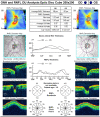Multiple Sclerosis Presenting with Sixth Nerve Palsy in a Child
- PMID: 34413685
- PMCID: PMC8370490
- DOI: 10.2147/IMCRJ.S320678
Multiple Sclerosis Presenting with Sixth Nerve Palsy in a Child
Abstract
We report a child with multiple sclerosis who presented with sixth nerve palsy. She is a twelve-year-old Bahraini female presented to the ophthalmology department complaining of double vision. She also had imbalance and paraesthesia. Extraocular muscle examination showed restriction of abduction in the right eye. There was no change in vision. MRI showed right eye optic neuritis (ON) and demyelination which was indicative of multiple sclerosis (MS). Ocular coherence tomography (OCT) showed thinning of nerve fibres of both eyes which was consistent with subclinical optic neuritis. Neurological examination showed brisk knee jerk on the left side and incoordination of movement on the same side. Disability Status Scale (EDSS) showed a score of 3.0. She was given Solu-medrol 500 mg intravenously (IV) in addition to omeprazole 40 mg IV and Vitamin D3 (cholecalciferol) 50,000 IU cap weekly for 8 weeks and Neurorubine forte tablets (vitamin B1, 6, 12) once a day for 2 months. She became asymptomatic in her follow-up visits. Children with MS can present as sixth cranial nerve palsy. Clinicians should have a high index of suspicion for early diagnosis and treatment. In addition to MRI, OCT is a useful diagnostic tool for optic neuritis and MS especially in children.
Keywords: demyelination; diplopia; lateral rectus palsy; ocular coherence tomography.
© 2021 Al-Yousuf et al.
Conflict of interest statement
The authors report no conflicts of interest in this work.
Figures



References
-
- Charcot M. Histologie de la sclérose en plaques. Gaz Hosp. 1868;41:554–556.
Publication types
LinkOut - more resources
Full Text Sources
Miscellaneous

